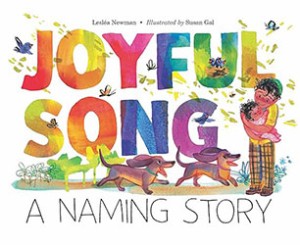Loving parents have used any number of colorful names to designate their out-of-control children. In Yiddish, one word for these adorable troublemakers is mazik. Yael Levy and Nabila Adani have spun an affectionate tale defining these incorrigible creatures, posing questions about their activities and depicting their hectic, and Jewish, daily lives. From start to finish, young readers and their caregivers will enjoy accompanying these playing, snack-eating, alef-bet learning, and sh’ma-reciting kids throughout their busy day.
Actually, these mildly destructive imps are not exactly children; they have pink-and-green skin and tiny, nonthreatening fangs and claws. They are an homage to the great Jewish children’s book author Maurice Sendak, whose journey to the wild things ends with a reassuring trip home. Adani’s cover shows the small monsters with two books. One is a standard alphabet story opened to “D is for Dreidel,” conjuring the joy of Hanukkah, while the other is a volume of Jewish folklore. It seems the maziks are acknowledging their origins in the rich legends of Jewish tradition. But they live in the here-and-now, waking up in bedrooms littered with toys, eating a messy breakfast, and going to school where they “follow all the rules,” if only briefly. Children will identify with their good-natured defiance, while parents will relate to the chaos of their “making trouble, breaking stuff.” Even the relatively laid-back mom in jeans and a sweatshirt poses with her hands on either side of her head, a universal gesture of frustration.
The Jewish dimension of the story is unobtrusively integrated into the overall theme: there is a shelf in the kitchen with Sabbath candles and kosher salt; the class blackboard shows the Hebrew alphabet; and their Friday evening table includes challah, candles, and grape juice, the final item resulting in a messy spill. These limit-pushing kids and their obviously human parents are Jewish in a matter-of-fact way, their religious identity providing the meaningful routines of each day. Levy follows factual descriptions of what the maziks do with questions, inviting children to verify the essential realism of these mythical beings: “Do they laugh until they drop? What do maziks do each day?”
Adani’s pictures are full of joyful and action-filled scenes. Her constantly smiling maziks make it clear that they mean no harm, and their impressive energy level captures a part of childhood that adults can only fondly remember. These children never stop their creative disruption, at least until it is time for the respite of sleep. The seamless transition from a wild pillow fight to the dark peace of moon and stars will help to calm everyone even if those “dreams that glide on starlit thread” are sure to include the next day’s havoc.
Emily Schneider writes about literature, feminism, and culture for Tablet, The Forward, The Horn Book, and other publications, and writes about children’s books on her blog. She has a Ph.D. in Romance Languages and Literatures.





